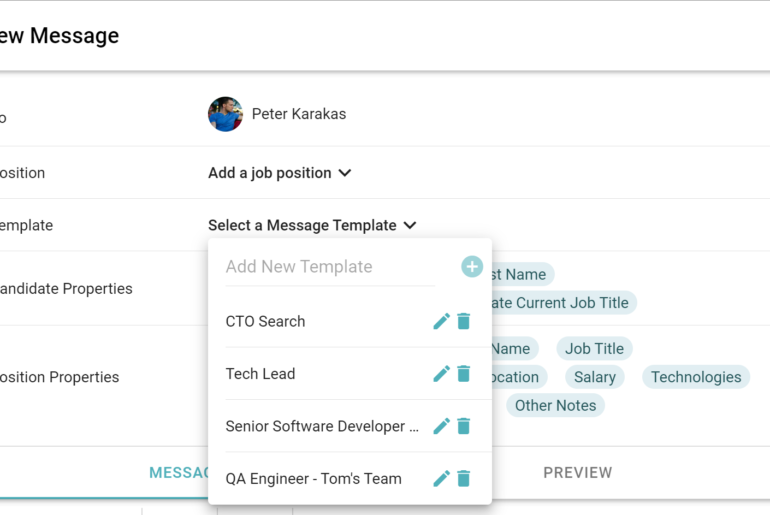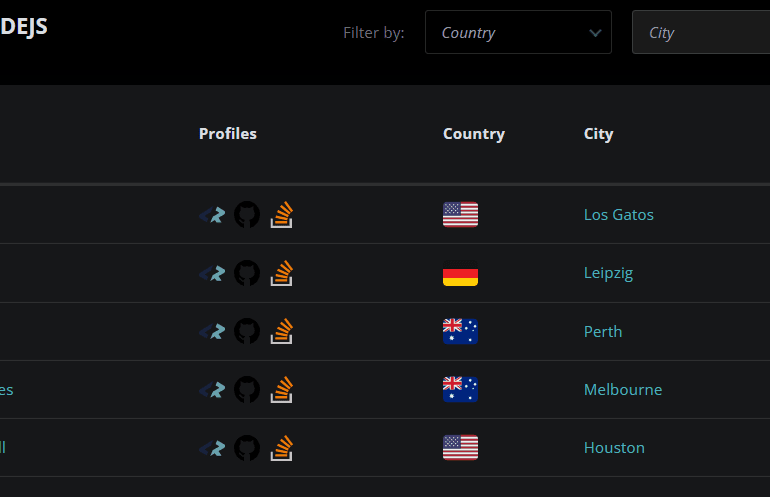The tech recruitment space keeps getting more and more competitive as the years go by. Practically every company is looking to hire the best developers on the market. There are more job openings than the number of available talent.
As a result, to source and screen for the best developers is one of the biggest challenges for hiring managers and recruiters. When you factor in experience, diversity, specialized skills, and the fact that over 70% of qualified candidates aren’t actively seeking jobs, the process becomes even more daunting. (jump to this section to see how CodersRank solves this problem)
Gone are the days when all you had to do was sit back and wait for candidates to send in their applications. If you want to get in touch with top-tier talent, you have to go searching for them.
This means tweaking your talent acquisition strategy and embracing creative ways of sourcing, screening, and evaluating candidates.
Being proactive about sourcing and screening developer candidates will give you access to a larger pool of better-suited hires. It will also help you build strong talent pipelines to cover your current and future hiring needs.
It’ll streamline and increase the efficiency of your hiring process, reduce costs-per-hire, and allow you to fill open positions quickly.
📖 In this post, we’ll show you how to become adept at finding and evaluating the right developers for your company. You never again have to deal with the stress of sifting through seemingly bottomless stacks of ill-fitting resumes.
We broke down the tips to two categories: basic & advanced. Jump to the section you want to learn more about below:
Basic techniques
- Source and screen developers on social media
- Review developer blogs and websites
- Conduct interviews with technical assessment tools
- Tap into your own network (but strategically)
- Use the boolean search feature on CodersRank
Advanced techniques
Before you proceed, grab a copy of our latest sourcing ebook

The basics
1. Source and screen developers on social media

Even though this sourcing method is one of the most effective source of quality hires after referrals, many modern recruiters neglect how powerful a tool social media can be. It can aid you in identifying, assessing, and attracting quality developer candidates.
Taking your search to social media platforms where developers like to hang out can:
- improve the quality of prospective candidates by 49%
- reduce your time to hire by 33%
- increase the quantity of candidates by 43%.
Beyond building your brand reputation and advertising your company’s open roles, you can use social media to take your employee search to the next level. How? Simply collect work samples, resumes, contact information, and other data on potential candidates.
Here are some of the best ways to find developers and streamline your talent sourcing and screening process using social networks.
Get a LinkedIn Recruiter License
As you know, LinkedIn is the world’s largest professional network. People from all walks of life, including developers, use it for different professional goals. They showcase accomplishments, share their career history, interact with other professionals, and position themselves for recruiters to find.
If you don’t have a company page on LinkedIn already, create one and start building an interesting profile. If you have one, you need to get active. You can use a company page to:
- set up a careers page
- start sharing engaging content/updates
- build a strong employee advocacy program,
- source for developers through referrals and recommendations from your network.
However, this process can take a while to start yielding results, which is where LinkedIn Talent Solutions come in.
With this feature, you can leverage the magic of advanced search filters and data-driven insights to find and recruit the best candidates.

When sourcing for candidates on LinkedIn, try to go beyond using simple search terms like “front-end developer,” “python,” or “team player”. These searches will return the same basic results that everyone else is getting.
To discover hidden talent that are more capable and not being chased by a thousand other recruiters, include advanced search terms. These terms should describe the responsibilities that candidates handle at their jobs. Terms like design, lead, create, manage, creative solutions are a good example.
Don’t just go through the work experience and skills sections of candidates’ profiles and call it a day. People tend to lie or overembellish their abilities on their resumes.
Check other aspects of their profile. Do they even have a complete profile? How does their summary section read? What does it tell about the value they can add to your organization? Do they have examples of their work or links to their portfolio and code repositories on their profile?
Have they gotten or given recommendations to others? If they have, that could suggest that the candidate possesses good communication, collaboration, and people skills.
As important as it is to scrutinize LinkedIn profiles before selecting potential hires, try not to go overboard with it.
Keep in mind that it’s mostly active job seekers and newbie developers who update their profiles frequently. People can have more relevant skills than their profile indicates so don’t be too quick to dismiss candidates on their resume alone.
💡 Bonus tip: we are big fans of recruiting expert Hung Lee! Make sure to keep an eye on recruitingbrainfood.com for more practical info on sourcing on LinkedIn and elsewhere. Ep. 61, Levelling up your candidate sourcing skills, is an especially great episode from his Live on Air series.
Use GitHub
With over 30 million developers on the platform, GitHub is one of the largest online open-source repositories for coders. Developers use the site to store the projects they’re working on so they can track code changes and contribute to open source projects.
With a GitHub account, you can start screening and evaluating candidates from this large talent pool. Once your account is set up, you can search developers for hire using three parameters:
- Followers — The amount of followers a user profile has indicates how much respect and authority they have in the developer community. A number between 2-10 is considered good, 26-75 is truly remarkable, and anyone with 75+ followers might as well be wearing a superman cape. With that said, keep in mind, that majority of developers do not have a huge following. Use this metric only as a supporting detail of your candidate.
- Language — Specifying the language skills that you’re looking for in a candidate can help narrow down your search.
- Location — Unless you’re looking for remote employees, it’s vital to include the location (city or country).
Let’s say you want to hire a developer who has more than 30 followers, is skilled in Python, and resides in Tokyo. Your search will look like this:
followers:>30 language:python location:tokyo
Once you enter your search parameters, GitHub will show you results for repositories of developers that match your criteria.
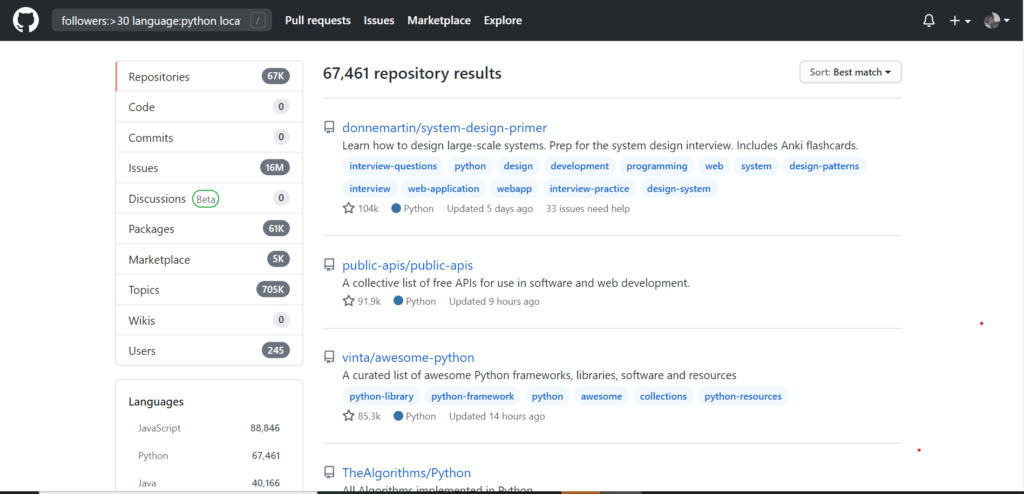
To get to see the people behind the repositories you have to filter your search results by users or candidate skills using the following steps:
- On the left side of the results page that GitHub displays, you’ll find a menu listing a bunch of information. Select Users.
- Github will then amend the results so you can see the actual profiles of the candidates.
- Your results will automatically be shown according to what GitHub seems to be the Best Match. You can filter even further by scrolling to the right side of the screen and clicking the Sort tab.
- From here you can screen candidates based on the number of followers they have, how recently they joined the platform, and the number of repositories they’ve made. Generally, candidates who have the most repositories and followers, and have spent more time tend to have the most skills.
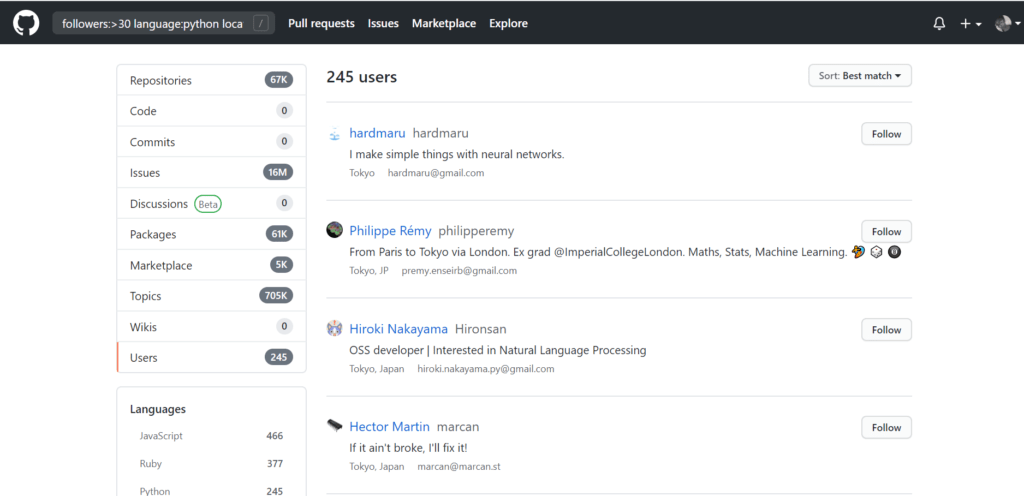
An advantage of this sourcing technique is that it allows you to view and analyze a developer’s code samples. It gives you an idea of the kind of projects they’ve worked on before approaching them with your job offer.
Use StackOverflow

Image source: undraw.co
If there’s any developer community that rivals GitHub, it’s StackOverflow. The Q&A site is a trusted resource for programmers at all stages of their careers. Here, they can learn more about coding and find solutions to day to day programming problems from fellow developers. This makes it a great platform for sourcing qualified developer candidates.
Every question posted on StackOverflow is tagged with a programming or application language. You can use those tags to browse through answers and find developers who have the skills you require.
To begin shortlisting potential hires for your company on the platform, you can simply register an account and put the search features to good use. You can also click on “Users” to look through the entire user database.
Looking at potential candidates’ StackOverflow history will provide you with important information about them, such as:
- their website
- location
- recent activity
- preferred programming languages
- projects they’ve worked on
- how long they’ve been a member
- reputation
- links to other social media profiles.
The questions they’ve asked or the answers they’ve provided will give you an idea of where they are in their coding journey, how they approach or solve problems, and what they’re currently working on.
StackOverflow categorizes developers according to their reputation scores and user badges. You want a candidate that ranks high in both. One very useful badge that you can use to filter candidates and find the most qualified of the bunch is the “great answer” badge.
This badge is given to an answer with a score of 100 or more. It’s a rare badge to get and it shows that the developer who provided it really knows their stuff.
If you want to filter your search for users who have given a great answer, follow these simple steps:
- Log in to StackOverflow, see the upper right corner of the page, and click on the ❔ button.
- Select Tour from the list of options and you’ll be taken to a new page.
- Scroll down until you get to the Unlock badges for special achievements section, then click on see all badges.
- Keep scrolling down until you find the Great Answer badge and click on it. You’ll be directed to a page where you can view user profiles of developers who have been awarded this badge and the questions they addressed to earn it. You can then evaluate their profiles to see they suit your requirements.
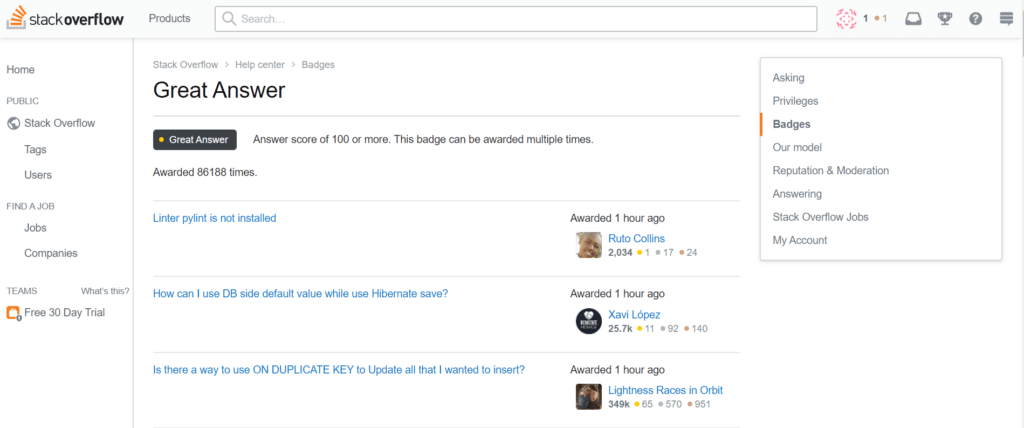
Alternatively, you can use Google X-ray. Simply search for Great Answer badges on StackOverflow who reside in a specific location or are skilled in a particular language.
To perform an X-ray search, simply:
- Head over to your browser and enter the following string into the search bar (site:stackoverflow.com/users “great answer” london javascript) using your desired location and language.
- Google will display results of user profiles that match the criteria and you can take over the investigation from there.
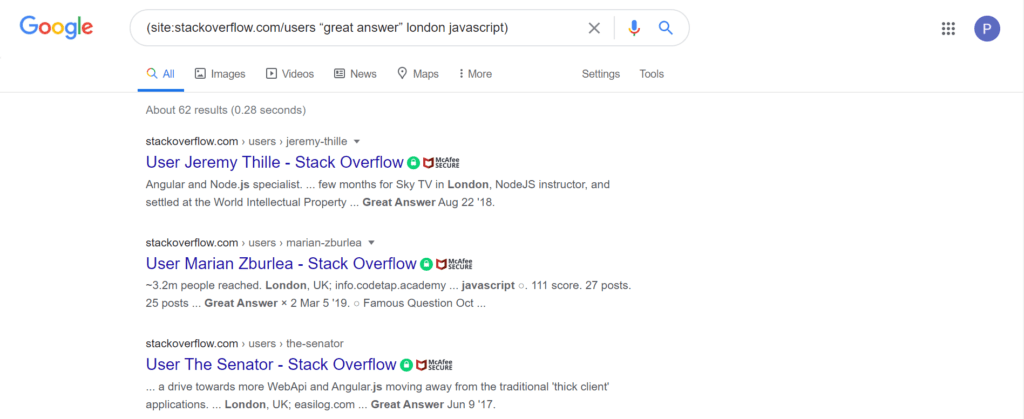
2. Review developer blogs and websites
Before hiring developers, it makes sense to visit and evaluate their blogs or websites. Doing this can provide valuable insights into a potential candidate’s approach to problem-solving, depth of perception, writing skills, technical expertise, and even personality. All of these can be crucial factors in identifying strong prospects.
During this screening process, take the time to analyze their design and review their source code. Developers who can execute a design efficiently using minimal lines of code? A dream! They will be a much more valuable hire than those who tend to work with a chunkier code base.
Check to see if they custom coded the website/blog from scratch? Did they use a pre-built template? Or got someone else to build it for them? Test the responsiveness of the page on mobile. Does the general design follow best practices? Does it look attractive and professional or is a developer/user’s nightmare?
If possible, ask them about their user interface and experience design choices. This will gauge their ability to articulate their vision for the website and whether they succeeded in realizing it.
💡 Keep in mind that screening candidates based on the design of their website/blogs may not always be relevant. For instance, a front end developer would almost always have a better site with visually pleasing and fascinating designs.
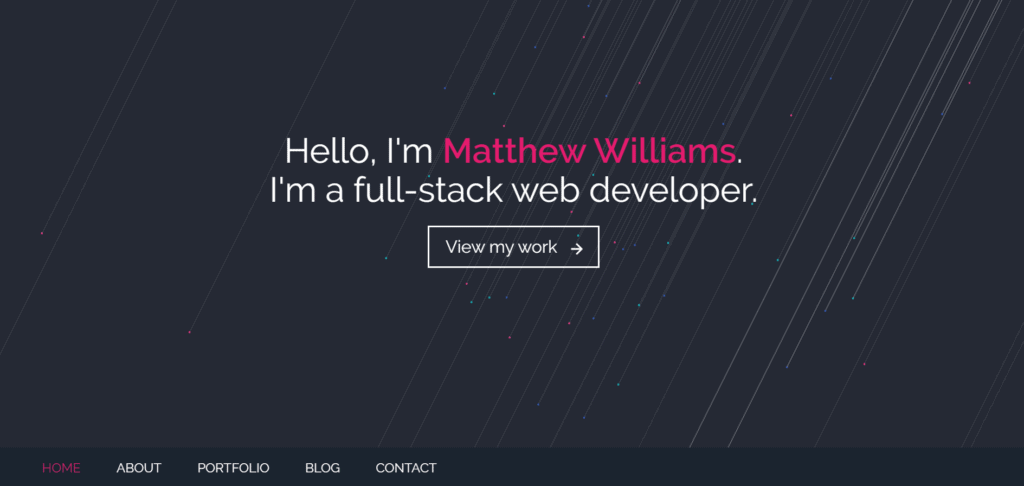
On the other hand, a backend developer’s site may not be much to look at. In such cases, it’s better to focus your evaluation on the content of their site, rather than the design.
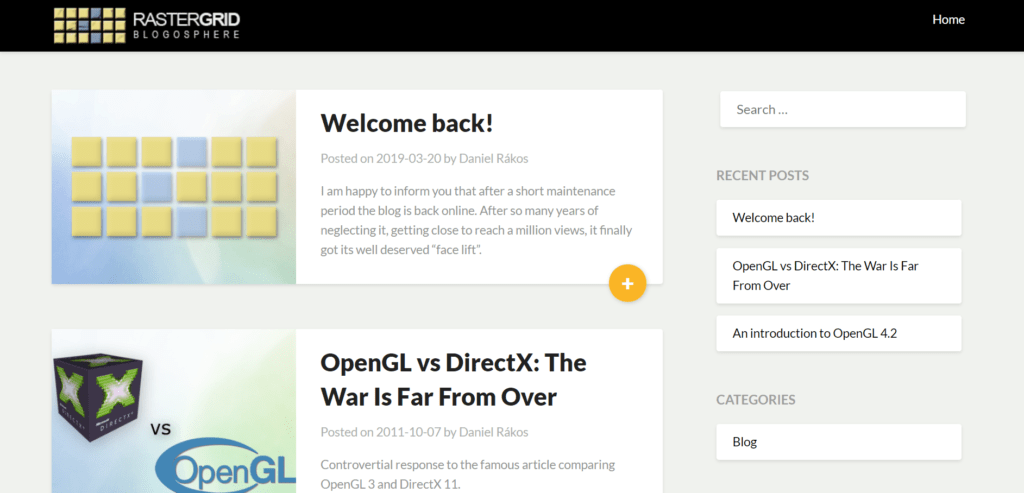
3. Conduct interviews with technical assessment tools
Online assessment tools like HackerRank, Coderbyte, Codility, TestDome, and InterviewMocha have been helping modern recruiters streamline their interview process. They help you determine which developer candidates they should continue screening or propositioning.
These tests are easy to create and administer. The results are presented in a way that anyone, including non-developers, can understand. They’re especially useful for companies that are hiring remotely, and as such, cannot conduct face-to-face screenings for potential hires.
With these tools, hiring managers and recruiters can efficiently evaluate a large number of candidates within a short period. They can significantly improve the screening experience for every candidate.
All the candidates will be asked the same set of questions. Then, they will have to create the appropriate code in the environment of their choice. This method usually makes them more relaxed and able to tackle the tests to the best of their abilities.
These tools offer skill-based tests in various programming languages. They can measure complexity, the time taken to complete the test, code correctness, and other elements. Hiring managers will have an accurate assessment of the technical competencies of each applicant.
Yahoo was rocked with a major scandal in 2012 that led to the then CEO, Scott Thompson, resigning in disgrace. It was discovered that he had lied about having a computer science degree.
Reports show that 46% of resumes contain pure lies and up to 78% of them are misleading. Assessment tools help you weed out developers who are exaggerating or lying about their skills by testing the skills in question.
You can also test for cultural fits such as cognitive ability and personality traits with some assessment solutions.
An added benefit of this screening method is that it leaves little to no room for bias in the employment process. Recruiters will not be able to tell a candidate’s race, gender, age, or ethnicity by their test results.
However, it’s important to note that there is still considerable risk to interview assessment tools. Since candidates are not performing the tests in front of you, they can find a way to game the system by cheating.
Sometimes a testing service can score a candidate very low because their answers don’t match the evaluation metrics being used even though their solutions are actually brilliant, elegant, and accurate.
It’s also possible to get false negatives and false positives with candidate ratings. This can lead to the qualified candidates being disqualified and resources being wasted on interviewing or hiring poorly-suited prospects.
The pressure to complete the tests within an allotted time-frame doesn’t help either. At the end of the day, it’s much better to rely on in-person tests or evaluate candidates based on long-term performance.
4. Ask your personal network for referrals
Referrals are leading the charge as the most productive and creative way to find qualified developers for hire.
Get your employees involved in the sourcing process by encouraging them to refer qualified candidates for open roles. There’s a good chance they know someone who fits the bill or who can recommend someone else that qualifies.
Ask for referrals from your friends, associates, and business partners. There’s a good chance they’ve worked with a super talented developer that’d be perfect for your open role. Bonus: they can vouch for them.
Also, referrals reduce time-to-hire and increase the likelihood of a candidate accepting your offer. In these cases, they likely value the opinion of the person who recommended them.
You can strengthen your employee referral program and motivate other people in your network to refer quality candidates. Simply try offering monetary and non-monetary incentives.
5. Use Boolean Search on CodersRank
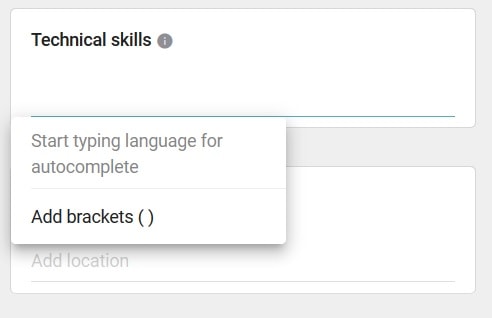
Boolean search is an advanced search technique that combines the keywords you’re looking for with operators like AND, OR, NOT, ” “, and ().
You can craft Boolean search commands to find relevant developer candidates across the web including Google and CodersRank.
Let’s say you want to find back end developers who are fluent in Python and JavaScript on Google, your Boolean string would look something like this:
(intitle:resume OR intitle:cv) “back end developer” (Python OR Javascript)-job -jobs -sample -examples
Make your searches as targeted as you want by adding other criteria like location to get more relevant results. To learn more about how to use Boolean search strings to find developers on Google, see this guide.
You can use Boolean commands the same way on CodersRank to make your search for qualified developers easier and faster. However, our talent search engine only supports AND and OR operators at the moment, but not the NOT.
Advanced techniques for finding the best tech talent
1. Utilize CodersRank’s repo analysis feature
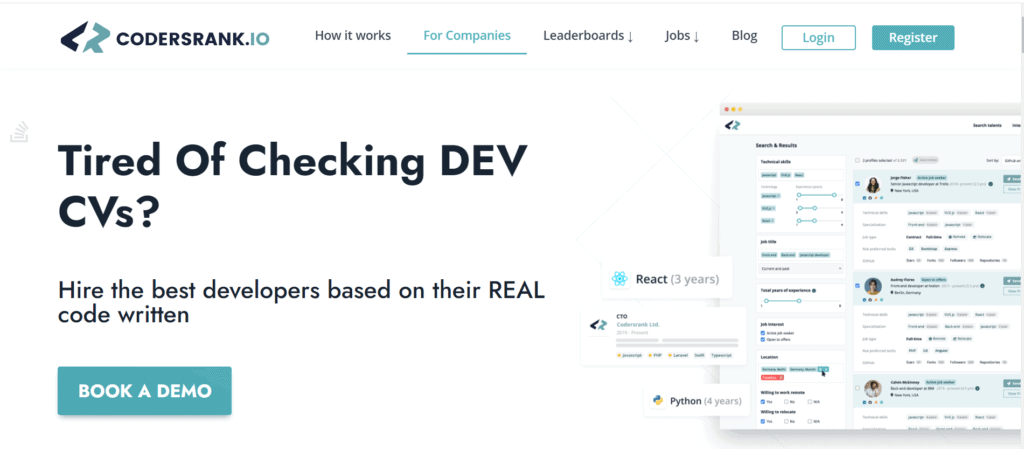
CodersRank allows you to source, evaluate, and hire the best developers by analyzing the actual code they’ve written. Their code can come from both public and private repositories.
First, developers connect their GitHub, StackOverflow, GitLab, and LinkedIn accounts to their CodersRank profiles. After this, our algorithm calculates experience points and displays the developer’s experience using visual charts. This way, recruiters and hiring managers can easily see a candidate’s growth, capabilities, and where they are in their careers.
Our goal with the scoring is to measure a developer’s true experience in the given language. Usually, their experience is measured in years, but that’s not the best method. Why? Because it doesn’t take a lot of things into consideration. For instance, they might say they have 5 years of experience in Java. That statement doesn’t tell you the most important information. How active were they in those 5 years? How much did they forget? It is exactly this problem that we tried to solve with our scoring system.
Let’s take the topic of experience one step further. What if your dream candidate was NOT on LinkedIn to showcase his or her work history and experience? It’s rare, but it happens. A growing number of devs are resistant to mainstream social media. They choose to be more active members of startup-led, community-based platforms, such as CodersRank. In order to keep up with developer preferences, it’s time to look beyond LinkedIn.
A growing number of devs are resistant to mainstream social media and choose to be more active members of startup-led, community-based platforms, such as CodersRank.
CodersRank is not a scraping tool – it’s a community
90% of recruiters use the same old recruiting tools. Everyone gets the same scraped data that may or may not be accurate. This is why CodersRank is different. CodersRank shows you a developer’s true experience AND their manually submitted info.
If you’re looking for a great recruitment tool for finding, evaluating, and contacting qualified developers who are actively or passively seeking jobs, CodersRank is your go-to. There’s no need for unnecessary qualification rounds, analyzing technical skillsets, or candidate’s experience because we’ve done the work for you.
CodersRank’s recruiter tool works on a simple premise. You filter for prospects based on the tech stack and languages you require. Then you reach out to shortlisted candidates through the internal search. And then? Thanks to our high response rates, you will hear back from them very soon.
Here’s how to use CodersRank recruiter search feature:
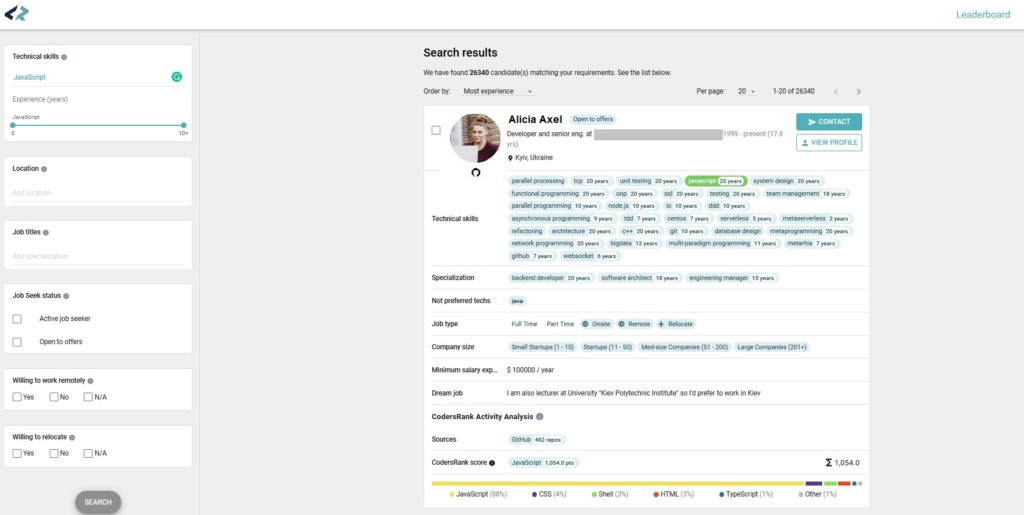
- Sign up on the CodersRank recruiter platform by booking a demo. During this demo, we’ll give you a quick walkthrough of our platform.
- Once that is done, you can start searching by entering the technical skills you’re looking for. You can just add one skill or more, thanks to the boolean search functionality. Jump to learn more about boolean.
- CodersRank will return all the developers in our database in just a few seconds. The beauty of CodersRank is that candidates can specify whether they are active or passive job-seekers.
- You can then scroll to the Order by tab and filter results by Most experience, Job Interest change, or Recently created.
- From there, you can narrow down the list of candidates even further using Location, Job Title, their Willingness to work remotely or relocate, or adding even more desired skills.
- By now you should have a bunch of amazing candidates that are an ideal fit for the position you’re looking to fill. Look through their profiles to learn more about them and any job preferences they might have.
- When you’re satisfied with what you see, all that’s left to do is reach out to the shortlisted talents. You can do so with personalized messages using one of our messaging channels (direct emails for now – inmail coming soon!) and extend an interview invitation to them.
There you go! Sourcing, evaluating, and hiring qualified developers have never been this easy.
2. How to avoid bias
Letting bias into your recruitment process can lead to your firm hiring the wrong candidates and damaging their reputation.
People can tell when they’re being treated unfairly, judged, or denied jobs based on irrelevant characteristics that have nothing to do with their qualifications or impedes their ability to do the job well.
If word gets out that your company’s hiring process is riddled with bias, nobody is going to work for you. You’re going to miss out on many amazing hires.
The trick to eliminating bias is to start by understanding the position you’re trying to fill. What does it require exactly? Who is your ideal candidate? Define the core skills, traits, and characteristics that make up your perfect prospect.
The next step is to set up a standard evaluation process for assessing candidates during and after the interview. This way, you’re not basing your judgment on your gut feeling.
💡 Related learning: tune in to Recruiting Brainfood’s “The Beauty Bias: Hiring in Era of Video“.
Things you’ll want to consider when screening developer candidates include:
- Interest in the position and your company.
- How prepared they were for the interview—did they thoroughly research the role, your company, and industry?
- Response time.
- Technical acumen and proficiency.
You should be able to articulate how you feel about every candidate based on facts. This will be useful later on when you need to provide rejected candidates with feedback or defend your hiring decision.
When you pass on candidates to the hiring manager, stay in contact and ask for feedback about the prospects. This way, you can adjust the desired profile if needed.
Final word before you fill your pipeline with the best candidates 👨💻 👩💻
Navigating the intricacies of sourcing, evaluating, and hiring developers is no easy undertaking even for the most seasoned recruiters. Knowing where to look and what strategies to apply can make a world of difference to your recruitment process.
These best practices discussed above will help you master the art of recruiting developers. You’ll be able to assemble a top-tier programming team that’s aligned with your company’s mission and culture in no time.
It’s important to remember that if you’re serious about attracting the best developer talents in the marketplace, you can’t do it without building a strong employer brand.
Do you have any beginner or advanced screening tips that you swear by? Drop us a message!


